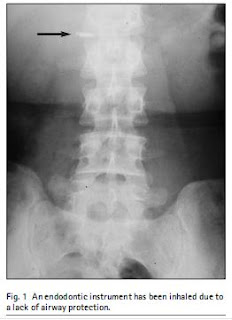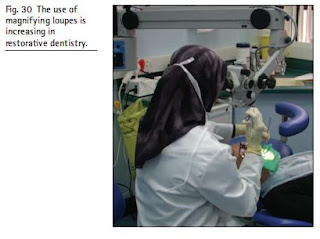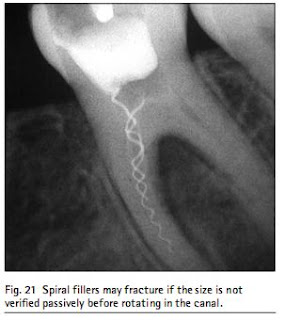Most manufacturers supply rubber dam in three thicknesses or grades, for different applications. Depending upon the manufacturer, these will be designated either light, medium and heavy, or medium, heavy and extra-heavy. The thinnest of the three is more prone to splitting, and the heaviest more difficult to manipulate, which means that the most widely used is the middle grade. The sheets are presented in a variety of colours, some being impregnated with peppermint and other scents to disguise the smell of the rubber. The feel of rubber against the skin may be countered by simply placing a gauze underneath the dam.
Wednesday, October 5, 2011
Endodontics: Part 6 Rubber dam and access cavities
RUBBER DAM
The use of a rubber dam is almost mandatory in modern endodontic practice for three reasons.
Firstly, it provides an aseptic operating field, isolating the tooth from oral and salivary contamination. It cannot be stressed enough that contamination of the root canal with saliva introduces new microorganisms to the root canal which may prolong treatment and reduce prognosis.
Secondly, rubber dam facilitates the use of the strong medicaments necessary to clean the root canal system.
Finally, it protects the patient from the inhalation or ingestion of endodontic instruments, as shown in Figure 1.
Practitioners may also be advised to develop their rubber dam skills for another reason. Research has shown
that rubber dam used during routine conservation procedures reduces aerosol contamination and cross-infection by up to 98.5%.
Research has also shown that patients do not dislike the use of rubber dam,
Sunday, October 2, 2011
Magnification
When asked why endodontics is a difficult subject, undergraduate and postgraduate students alike frequently reply that it is because they cannot see what they are doing. There is no doubt that magnification of the pulp chamber greatly assists in finding and accessing narrow canal orifices, and many practitioners now routinely use loupes, as seen in Figure 30. This one purchase has made huge improvements in the quality and ease of endodontic treatment for many practitioners. Indeed, the improved vision gained from the use of loupes improves all aspects of general dental practice, not just endodontics. The patient in the illustration is merely undergoing a routine examination.
Heat carriers
The application of heat to the gutta-percha filling permits improved lateral and vertical compaction of the softened material. Ordinary hand and finger spreaders are not designed for this purpose, but the instruments illustrated in Figure 27 may be used. They are of various sizes, and have both a pointed tip for lateral spreading, and a flat tip for vertical compaction.
Root canal filling instruments
Spreaders
Cold lateral compaction using gutta-percha requires either long-handled or finger spreaders (Fig. 26). These have a long, tapered shank with a sharp point. The instrument is used to compact gutta-percha laterally against the walls of the root canal and provide a space for the insertion of further gutta-percha points.
Cold lateral compaction using gutta-percha requires either long-handled or finger spreaders (Fig. 26). These have a long, tapered shank with a sharp point. The instrument is used to compact gutta-percha laterally against the walls of the root canal and provide a space for the insertion of further gutta-percha points.
Mineral trioxide aggregate
 Mineral trioxide aggregate (Fig. 25) is a compound consisting of mineral oxides, (tricalcium silicate, tricalcium oxide, silicate oxide and traces of other mineral oxides), developed first by Mahmoud Torabinejad and co-workers at Loma Linda University.
Mineral trioxide aggregate (Fig. 25) is a compound consisting of mineral oxides, (tricalcium silicate, tricalcium oxide, silicate oxide and traces of other mineral oxides), developed first by Mahmoud Torabinejad and co-workers at Loma Linda University.462 BRITISH DENTAL JOURNAL VOLUME 197 NO. 8 OCTOBER 23 2004
Although originally developed as a root-end filling material during periradicular surgery, researchers across the world have reported positive results when the material is used for the repair of perforations, as a pulp capping agent, and to induce apical closure of immature roots. The superb sealing ability, marginal adaptation and biological compatibility of the material appear to make this material the sealant of choice for any communication between the root canal system and the external surface of the tooth.
Saturday, October 1, 2011
Medicated
 The current thinking is that provided the principles of root canal preparation and filling are observed, there is no justification for the use of therapeutic sealers. The active ingredient in the majority of medicated sealers is paraformaldehyde, which is usually accompanied by a corticosteroid. Figure 24 shows a medicolegal case where excess medicated sealer entered the inferior dental canal, causing permanent nerve damage with paraesthesia of the lip and soft tissues.
The current thinking is that provided the principles of root canal preparation and filling are observed, there is no justification for the use of therapeutic sealers. The active ingredient in the majority of medicated sealers is paraformaldehyde, which is usually accompanied by a corticosteroid. Figure 24 shows a medicolegal case where excess medicated sealer entered the inferior dental canal, causing permanent nerve damage with paraesthesia of the lip and soft tissues. Non-eugenol sealers
Some sealers are manufactured with a calcium hydroxide base instead of zinc oxide/eugenol, for example Sealapex. This is promoted as having a therapeutic effect, although there has been little reported on this in the endodontic literature. It has been shown, however, that the calcium hydroxide is prone to leakage, which may result in unwanted voids in the seal.
Other sealers are manufactured that contain a wide variety of chemicals. AH+ is an epoxy resin base with a bisphenoldiglycidyl ether liquid. It has a long working time and seals well to dentine. The original AH26 initially caused a severe inflammatory response, which subsided after some weeks, but AH+ is far more biocompatible. Diaket is a polyketone and is presented as a fine powder and thick viscous liquid. The setting time is 8 minutes on the mixing pad and somewhat quicker in the root canal. A glass ionomer cement, Ketac-Endo, is available, which has a relatively low toxicity.
Other sealers are manufactured that contain a wide variety of chemicals. AH+ is an epoxy resin base with a bisphenoldiglycidyl ether liquid. It has a long working time and seals well to dentine. The original AH26 initially caused a severe inflammatory response, which subsided after some weeks, but AH+ is far more biocompatible. Diaket is a polyketone and is presented as a fine powder and thick viscous liquid. The setting time is 8 minutes on the mixing pad and somewhat quicker in the root canal. A glass ionomer cement, Ketac-Endo, is available, which has a relatively low toxicity.
Sealers/cements
Root canal sealers play an important role in the obturation of the prepared root canal system, as described in Part 8. Although many proprietary products are available (Fig. 23), they may generally be divided into three groups, according to their main constituents: eugenol, non-eugenol and medicated.
Eugenol
Eugenol
ROOT CANAL FILLING MATERIALS Gutta-percha
Gutta-percha is the most commonly used material for the obturation of the prepared root canal system. Standardized gutta-percha points correspond to the ISO sizing system with a 2% taper. Various other shapes are now available to complement the recently introduced increased taper filing systems (Fig 22). Gutta-percha is the dried resin of the Taban tree, and exists in two forms. Alpha phase is the natural form, but when heated and cooled the beta-phase results. This latter is normally used for root canal filling points.
Gutta-percha points in fact contain only about 20% gutta-percha. The major component
Fig. 21 Spiral fillers may fracture if the size is not verified passively before rotating in the canal.
Gutta-percha points in fact contain only about 20% gutta-percha. The major component
Fig. 21 Spiral fillers may fracture if the size is not verified passively before rotating in the canal.
Spiral root canal fillers
Spiral root canal fillers are seldom used in modern endodontics. Their main use is for the insertion of calcium hydroxide into the root canal. When a spiral filler is required, the blade type is preferred by the author, as this is the least likely to fracture. It is essential to ensure that the size selected fits loosely and passively to the required depth before the instrument is rotated in the root canal (Fig. 21).
Barbed broach
This instrument has sharp rasps pointing towards the handle. They may be used to remove the contents of the root canal before commencing shaping procedures. A vital pulp may be extirpated when carrying out elective endodontic procedures, or when treating a tooth with an irreversible pulpitis, by introducing the barbed broach deep in the canal, twisting it a quarter to a half turn, and withdrawing, as shown in Figure 20.
Subscribe to:
Posts (Atom)







